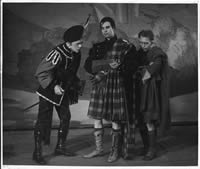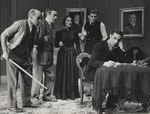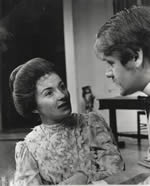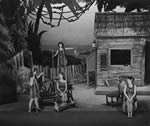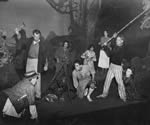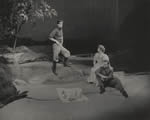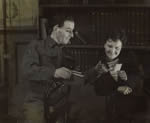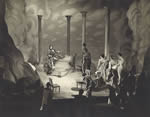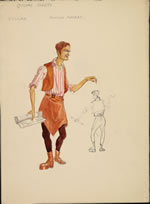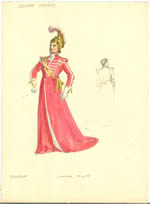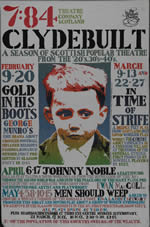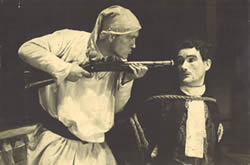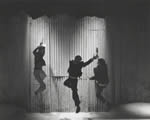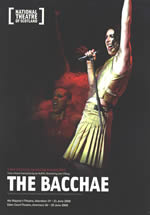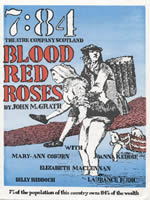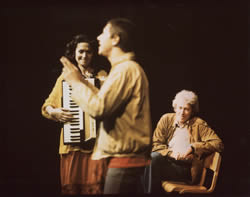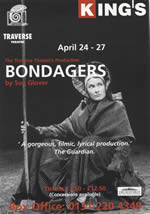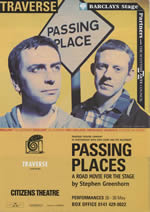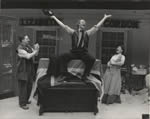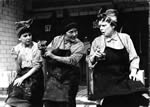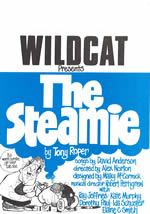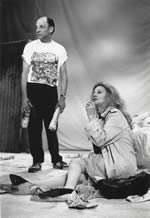Plays and playwrights
Adrienne Scullion
Scottish theatre is a theatre system and a theatre culture that has been generally untroubled by canonical play texts or the lives of great playwrights. Until modern times the core repertoire of Sir David Lindsay’s Ane Satyre of the Thrie Estaitis, Alan Ramsay’s The Gentle Shepherd and John Home’s Douglas, Joanna Baillie’s The Family Legend, and the plays of J M Barrie and James Bridie might struggle to be seen to constitute a procession of literary greats – even if each made a bold and popular addition to a contemporary theatre culture. And yet from the mid-1970s all that changed and today, if Scottish theatre is known for anything, it is probably for a raft of internationally produced playwrights like John Byrne, Liz Lochhead, David Greig, David Harrower and Gregory Burke. But dig a little deeper and there is a rich heritage that paved the way for these modern playwrights.
Before 1900
Whilst Sir David Lindsay’s Ane Satyre of the Thrie Estaitis (1542) remains a high point of European dramatic literature, subsequently Scottish audiences were little troubled by new plays and playwrights, even if there might have been a culture of touring performers, tumblers and musicians. In Scotland an audience for theatre evolved slowly: drama existed mostly in the closet form, with plays like Marciano; or, The Discovery by Edinburgh lawyer William Clerke (1663) and The Assembly (1695) and Tollerators and Contollators (c1703) by Alexander Pitcairne being circulated as printed texts in taverns, coffee- and chocolate-houses. In contrast a handful of plays made it into production in London including: Thomas St Serfe’s Tarugo’s Wiles; or, The Coffee House (1667), David Crawford’s Courtship a-la-mode (1700) and Love at First Sight (1704) and Newburgh Hamilton’s The Petticoat Plotter (1712) and The Doating Lover; or, The Libertine Tam’d (1715). But these rather minor pieces were overtaken as box offices successes when Alan Ramsay’s The Gentle Shepherd (1725) became the most successful pastoral of the eighteenth century and John Home’s Douglas (1756) found its place as a standard repertoire piece, associated with rise to celebrity of actors like Henry Johnstone, and the sister and brother team of Harriet Murray and W. H. Murray. Whilst Joanna Baillie established a reputation as an important woman of letters few of her plays really caught the theatrical imagination although her Plays on the Passions (1798) is a key drama text of the Romantic period. The essential history of the period is J C Dibdin’s The Annals of the Edinburgh Stage (1888) which, as the title suggest, focuses on stage history rather than dramaturgical achievements. With industrialisation popular entertainments grew as mass urban entertainment and Scotland’s theatrical traditions became firmly framed as popular – influenced by music hall and pantomime – Kirriemuir-born and Edinburgh-educated James Matthew Barrie (1860-1937) came to dominate UK stages.
For most of the Edwardian era, and well into the 1920s, J M Barrie was the most important and successful playwright in London and, hence, the most important and successful playwright in Britain. Walker, London (1892), Quality Street (1902), The Admirable Crichton (1902), Peter Pan, What Every Woman Knows (1908), Dear Brutus (1917), Mary Rose (1920) and others made Barrie a rich and influential figure in British cultural life. His clever and ambiguous plays – romantic and sentimental comedies framed with social commentary and tinged by the fantastical – captured the popular imagination. They enjoyed long, commercially successful runs on both sides of the Atlantic and featured some of the most popular actors of the age: Irene Vanbrugh, Nina Boucicault and, perhaps most frequently and influentially of all, Gerald du Maurier who created the roles of Hook in Peter Pan and John Shand in What Every Woman Knows.
The early and mid C20
A favourite question for students of Scottish theatre asks if the reputations of those most (commercially) successful of Scotland’s playwrights – Barrie and James Bridie (1888-1951) – can be salvaged. The frequent ‘answer’ is that, whilst both theatre makers, critics and historians have significantly recovered Barrie as a playwright, such a route is all but lost to Bridie, and it is in recognising his influence in shaping a modern professional Scottish theatre culture – first chairman of the Scottish Committee of the Council for the Encouragement of Music and the Arts in 1942, the founding director of the Citizens’ Theatre in Glasgow in 1943 and a leading player establishing the College of Dramatic Art, now part of the Royal Conservatoire of Scotland – rather than as a playwright, that there is any expectation of recovering his reputation.
Bridie’s writing career straddles an emergent professional theatre in Scotland and the highly commercialised, sophisticated theatre industry of the West End. His record there includes Mary Read (1934) with Flora Robson and Robert Donat; The King of Nowhere (1938) with Laurence Olivier; Mr Bolfry (1943), Dr Angelus (1947) and Mr Gillie (1950) with Alastair Sim, arguably the greatest proponent of Bridie’s antiheroes; and, Edith Evans and Peter Finch in Daphne Laureola (1949). However, with the founding of the Citizens’ Theatre in Glasgow, he wrote some of his best work – The Forrigan Reel (1944), The Queen’s Comedy (1950) and The Baikie Charivari (1952) – for it. Bridie’s dramas are ‘problem plays’, like The Anatomist (1930) and Dr Angelus (1947); morality plays, such as with Daphne Laureola and Tobias and the Angel (1930); and, fantasies, often centred upon a devil figure, such as The Sunlight Sonata (1928), Mr Bolfry and The Baikie Charivari. Bridie’s plays often concern a fight between good and evil, with a moral message that is disquietening and tinged black: in this context, at least, the devil very often commands the best tunes – or at least a seductive line in argument, as is the case with Dr Angelus. But today Bridie’s plays seem condemned to the bookshelf: his plays remain determinedly out of fashion.
In contrast contemporary plays from the amateur theatre scene – and in particular from the left theatre scene of the 1920s, 1930s and 1940s – have been successfully revived and celebrated as the dominant form of modern Scottish drama: popular, political, deeply connected to place and class. Particularly as a result of 7:84’s ‘Clydebuilt’ season in 1982 plays such as Joe Corrie’s In Time of Strife (1926), Robert McLeish’s The Gorbals Story (1946) and Ena Lamont Stewart’s Men Should Weep (1947) are familiar not only to students of Scottish theatre but to audiences too.
More like the popular phenomenon that was the now completely forgotten Bunty Pulls the Strings by Graham Moffat (1910), a huge success in London and on Broadway, Scottish theatre’s mid-century mainstream successes tend to be comedies or historical dramas, albeit with an interest in using Scots language and idiom. T M Watson’s Beneath the Wee Red Lums (1942) and Johnnie Jouk the Gibbet (1953), Robert Kemp’s The Other Dear Charmer (1953), Marigold (1954) and The Laird o’ Grippy (1955) and Alexander Reid’s The Lass wi the Muckle Mou’ (1950) and The Warld’s Wonder (1953) found production success at the Citizens’, the Gateway and, often, as BBC Radio dramas too. Whilst Robert McLellan’s Jamie the Saxt (1937) was successfully revived by the Citizens in 1947 and by the Scottish Theatre Company in 1982 his other plays, including Torwatletie (1946) and The Flouers o' Edinburgh (1948), remain less known, albeit he remains a popular and respected figure in the context of amateur drama in Scotland, where many of this period’s popular plays did maintain a foothold in the repertoire.
A parallel subgenre of plays in translation gradually emerges as generations of Scottish playwrights reimagined the international repertoire for home audiences, with Goldoni, Moliere and Brecht regularly providing inspiration. From Robert Kemp’s Let Wives Tak Tent (1948) to Victor Carin’s The Servant o’ Twa Maisters (1965), Edwin Morgan’s Cyrano de Bergerac (1992) and Liz Lochhead’s Educating Agnes (2009), through Douglas Young’s The Burdies (1959), Hector MacMillan’s The Hypocondriack (1987), Martin Bowman and Bill Findlay’s The Guid Sisters (1989) and Peter Arnott’s Mr Puntila and his Man Matti (1999), Scottish playwrights have been regularly drawn to classic European comedies as fitting the bold playwriting style of Scottish comedians.
After 1970
Despite this international perspective – which also includes a repertoire of tragedies not least Liz Lochead’s The Thebans (2003), David Grieg’s The Bacchae (2008) and Robert David MacDonald’s sustained engagement with the works of Goethe and Schiller for the Citizens’ – Scottish drama of the 1970s and after has been characterised and criticised as rather introspective, urban and quintessentially macho. Bill Bryden’s Willie Rough (1972) and Benny Lynch, Scenes from a Short Life (1974) and Tom McGrath’s The Hardman (both 1978) represented a popular depiction of ‘Clydeside-ism’, albeit with some dangerous edges to their nostalgia.
In the heady aftermath of John McGrath’s The Cheviot, the Stag and the Black, Black Oil (1972) both 7:84 and Wildcat presented a series of new political productions including Little Red Hen (1975), Joe’s Drum (1979), Blood Red Roses (1980), Harmony Row (1990) and Border Warfare (1990). But it was the Traverse Theatre in Edinburgh that was the powerhouse of new Scottish writing with a roster of great new plays running from John Byrne’s The Slab Boys, Tom McGrath’s and Liz Lochhead’s Blood and Ice (1982), through Peter Arnott’s White Rose, Chris Hannan’s Elizabeth Gordon Quinn and John Clifford’s Losing Venice (all 1985) to Sue Glover’s Bondagers (1991), David Harrower’s Knives in Hens (1995), Stephen Greenhorn’s Passing Places (1997) and David Greig’s The Speculator (1999). Alongside the work of the Traverse, the Royal Exchange Manchester premiered Iain Heggie’s scabrous A Wholly Healthy Glasgow (1987), 7:84 premiered Rona Munro’s Bold Girls (1990) and Wildcat presented the most successful play of the period with Tony Roper’s The Steamie (1987).
Even before the film, stage versions of Trainspotting (1994) brought a young and non-traditional audience into theatres across the whole of Scotland. This urban milieu has been of repeated concern for Scotland’s playwrights, a potent feature of, for example, Chris Hannan’s revisionary city comedies The Evil Doers (1990) and Shining Souls (1996), Anthony Neilson’s violent ur-realistic Penetrator (1993) and The Censor (1997), David Greig’s The Architect and Harrower’s eclectic and idiosyncratic Kill the Old Torture their Young (both 1998), each of which offers varyingly bleak views of the contemporary urban experience. Despite strong work from Sue Glover with Shetland Saga (2000), Zinnie Harris with Further than the Furthest Thing (2000), Nicola McCartney with Home (2001) and Cave Dwellers ( 2002), Linda McLean with Word for Word (2003) and Shimmer (2004), and Rona Munro with Iron (2002), modern Scottish theatre has remained dominated by male voices and representations of male experiences.
Henry Adam’s Among Unbroken Hearts (2000) explored a hard-edged reality of rural Scotland and concerned the alienating potential of place, youthful disillusion and a rural drug culture. Douglas Maxwell’s Our Bad Magnet (2000), Decky Does a Bronco (2000) and Helmet (2002), describe male communities and the games that boys play. Gregory Burke pursued an edgier attack on the shibboleths of Scottish masculinity in Gagarin Way (2001) – a tour de force of razor-sharp, demotic dialogue – and delivered a subtle revision of the history play with The Straits (2003) before Black Watch (2006) became the most successful of modern Scottish plays.
Today
Gregory Burke’s 2006 Black Watch, a play of verbatim accounts from former soldiers, scabrous black humour and ambitious theatricality brought a then new National Theatre of Scotland to the forefront of popular and critical attention. Subsequent new writing from the NTS has returned to the history play, always a popular form in Scottish theatre making. In 2010 David Greig’s Dunsinane used the Macbeth story to tell a story of border warfare and nation building, while at the 2014 Edinburgh International Festival Rona Munro’s trilogy of The James Plays caught a moment of cultural, social and political debate and celebration of the independence referendum.
But whilst the NTS has presented some major new plays it is the phenomenon of A Play, A Pie and A Pint that is the most prolific producer of new plays not just in Scotland but in the UK. Lunchtime theatre out of the pub venue Oran Mor in Glasgow,` A Play, A Pie and A Pint produces a new play every week and, as a result, has brought more new plays to an eager new audience than any other initiative. Launched in 2004 under the charismatic leadership of David MacLennan (1948-2014), A Play, A Pie and A Pint produces some 38 new plays a year presenting work by established playwrights including Liz Lochhead, Linda McLean, Rona Munro, Alan Spence, David Greig and David Harrower, first time plays by established novelists like Louise Welsh and Alan Bissett, emerging talents like Sylvia Dow and Gary McNair and seasons of plays from Latin America, the Arab World, China, West Africa, the Caribbean, Russia and the Ukraine.
With key organisations like the Scottish Society of Playwrights, a professional members’ organisation that represents, develops, and promotes the interests and craft of playwrights working within Scottish theatre, and the Scottish Playwrights’ Studio, focused on developing new talent and enhancing the careers of established professionals, the plays and playwrights of Scotland remain at the forefront of the national debate.
Scottish Society of Playwrights
Further Reading
Anthologies include –
Decade’s Drama (Todmorden: Woodhouse, 1980) – plays of the 1970s including Robert David MacDonald’s Chinchilla (1977).
John Byrne, The Slab Boys Trilogy (Harmondsworth: Penguin, 1987).
Cairns Craig and Randall Stevenson, eds, Twentieth-Century Scottish Drama (Edinburgh: Canongate, 1999).
Bill Findlay, ed., Scots Plays of the Seventies: An Anthology (Edinburgh: Scottish Cultural Press, 2001) – includes other relevant plays written and produced in Scotland in the 1970s including Bill Bryden’s Willie Rough (1972); Tom McGrath, The Hardman (1977) and Roddy McMillan, The Bevellers (1973).
Robert David MacDonald, Webster; Summit Conference; Chinchilla; The De Sade Show (London: Oberon, 2004) – including Chinchilla (1977); Summit Conference (1978).
John McGrath, Six Pack: Plays for Scotland (Edinburgh: Polygon, 1996).
Secondary materials include –
Alasdair Cameron, ‘Scottish drama in the nineteenth century’, The History of Scottish Literature, volume 3, the Nineteenth Century ed., Douglas Gifford (Aberdeen: Aberdeen University Press, 1988), pp. 429-441.
Alasdair Cameron, Adrienne Scullion, et al, ‘Contemporary Scottish drama’, Scottish Literature, ed. Douglas Gifford (Edinburgh: Edinburgh University Press, 2002), pp. 794-833.
David Hutchison, ‘Scottish drama, 1900-1950’, The History of Scottish Literature: volume 4: the twentieth century, ed. Cairns Craig (Aberdeen: Aberdeen University Press, 1987), pp. 163-177.
JT Low, Doctors, Devils, Saints and Sinners: a study of the major plays of James Bridie (Edinburgh: Ramsay Head, 1980).
Helen Luyben, James Bridie: clown and philosopher (Pennsylvania: Pennsylvania University Press, 1965).
Jan McDonald, ‘Scottish women dramatists since 1945’, A History of Scottish Women’s Writing eds Douglas Gifford and Dorothy McMillan (Edinburgh: Edinburgh University Press, 1997), pp. 494-513.
Adrienne Scullion, ‘New Scottish drama: the repertoire of the Traverse Theatre, Edinburgh’, Alba Literaria: A History of Scottish Literature ed. Marco Fazzini (Venezia: Amos Edizioni, 2005), pp. 763-82.
____, ‘Feminine pleasures and masculine indignities: gender and community in Scottish drama’, Gendering the Nation: Studies in Modern Scottish Literature ed. Christopher Whyte (Edinburgh: Edinburgh University Press, 1995), pp. 169-204.
Randall Stevenson, ‘Border warranty: John McGrath and Scotland’, Freedom’s Pioneer: John McGrath’s Work in Theatre, Film and Television eds David Bradby and Susanna Capon (Exeter: University of Exeter Press, 2005), pp. 73-85.
____, ‘Scottish theatre, 1950-1980’, The History of Scottish Literature: volume 4: the twentieth century ed. Cairns Craig (Aberdeen: Aberdeen University Press, 1987), pp. 349-67.
Randall Stevenson and Gavin Wallace, eds, Scottish Theatre since the Seventies (Edinburgh: Edinburgh University Press, 1996).
Terence Tobin, Plays by Scots, 1660-1800 (Iowa City: University of Iowa Press, 1974).
 001_150.jpg)
